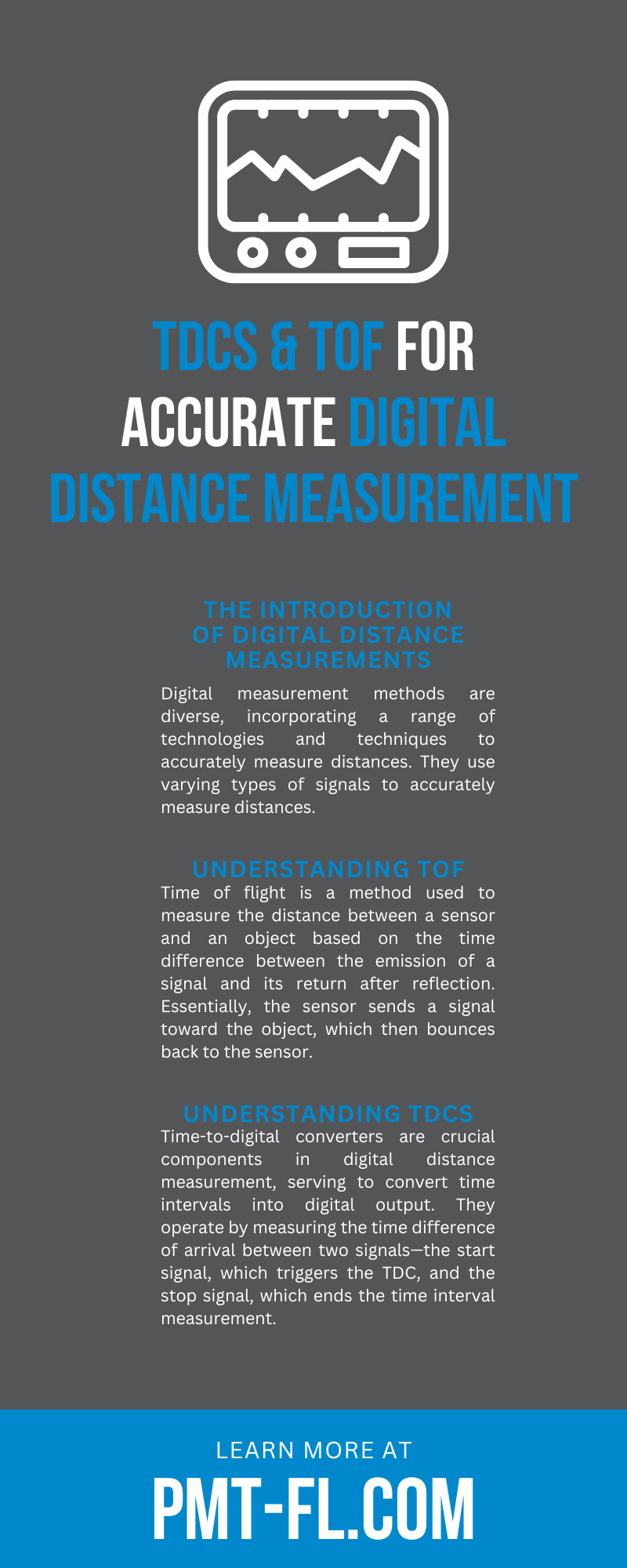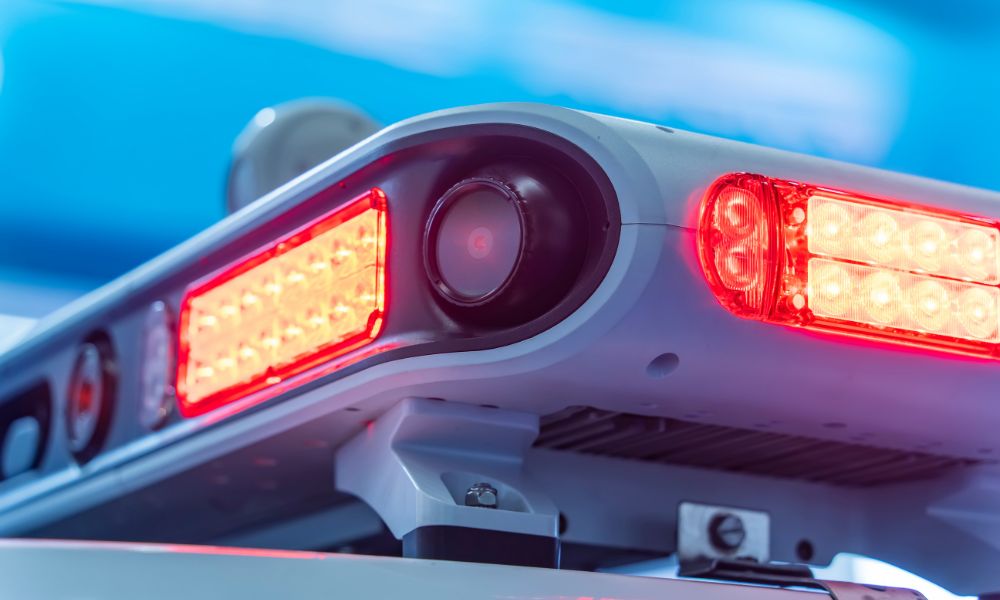Distance measurements provide essential insight that can be used in many ways, from construction layouts to engineering concepts. How we measure distances continues to evolve over the years, especially as more technological innovations arise. Digital distance measurements (DDM) are a contemporary technique employed to measure distance with high precision and accuracy. Time-to-digital converters (TDCs) and time-of-flight (ToF) concepts are among the most precise measurement solutions for distance calculations today.
If your product, research, or business needs to calculate distances, TDCs and ToF are the best technology for the job. What makes TDCs and ToF ideal for accurate digital distance measurements? Explore the benefits, influences, and capabilities of these technological solutions.
The Evolution of Measuring Distances
Before digital methods became the norm, we collected distance measurements manually. The simplest method involved manual measurement using a tape measure, which is still widely used today for short-distance measurements. For longer distances, surveyors relied on tools such as theodolites, which measure horizontal and vertical angles, and chains or rods of a known length.
People also commonly calculated distances through triangulation, a method that determines the location of a point by forming triangles to it from known points. For astronomical distances, people employed methods such as parallax or brightness measurements of celestial objects. While not as accurate or convenient as modern digital techniques, these methods laid the groundwork for today’s advanced distance measurement technologies.
The Introduction of Digital Distance Measurements
Digital measurement methods are diverse, incorporating a range of technologies and techniques to accurately measure distances. They use varying types of signals to accurately measure distances. The most common are:
- Light
- Radio
- Sound
- Electromagnetic
Each type of signal has advantages and limitations, and the choice of signal often depends on the specific application and environmental conditions.
Importance of Accurate Digital Distance Measurements
Accurate digital distance measurements are critical to the efficacy and reliability of numerous applications across a variety of sectors. In robotics and automation, precise distance measurements are essential to ensure efficient operations and avoid collisions, fostering a safe and productive environment. In vehicle safety systems, the accuracy of digital distance measurements can mean the difference between a timely response and a collision, with direct implications for road safety. In medical imaging, the precision of these measurements directly correlates to the quality of diagnostics and the ultimate health outcomes for patients. Accurate digital distance measurements underpin the safety, efficiency, and success of a broad range of applications.
Understanding ToF
Time of flight is a method used to measure the distance between a sensor and an object based on the time difference between the emission of a signal and its return after reflection. Essentially, the sensor sends a signal toward the object, which then bounces back to the sensor. The time taken for this round trip is used to calculate the distance between the sensor and the object, considering the speed of the signal. ToF technology is critical in various applications, such as 3D imaging, LIDAR systems, and robotics, offering precise and efficient distance measurements.
Understanding TDCs
Time-to-digital converters are crucial components in digital distance measurement, serving to convert time intervals into digital output. They operate by measuring the time difference of arrival between two signals—the start signal, which triggers the TDC, and the stop signal, which ends the time interval measurement. The collected time difference is then converted into a digital form.
The working principle of TDCs is based on the ToF concept. The time taken for this round trip is recorded and converted into a digital signal by the TDC. This digital signal, which is a reflection of the time taken, is then used to calculate the distance between the source and the target, taking the speed of the signal into consideration.
TDCs have significantly improved the precision and accuracy of distance measurements. They provide high resolution and low nonlinearity, which translates into very accurate time interval measurements. This enhanced precision is crucial in a variety of applications, including distance measurement in LIDAR systems for autonomous vehicles, time-of-flight mass spectrometry, and particle physics experiments. By reducing errors and increasing resolution, TDCs help ensure distance measurements are as accurate and reliable as possible.
Application of TDCs and ToF Technology
TDCs and ToF technology for distance measurements are multifaceted, providing multiple applications across an array of industries and systems.
LiDAR Systems
LiDAR (light detection and ranging) systems, widely used in autonomous vehicles, employ both TDCs and ToF technology to deliver precise spatial data. They send out light pulses and measure the time taken for these pulses to return after reflecting off objects. This data is then converted into digital signals by TDCs, providing accurate 3D representations of the environment that are crucial for navigation and object detection.
Robotics and Automation
In the robotics and automation industry, TDCs and ToF technology play a crucial role in tasks such as object detection, navigation, and collision avoidance. Sensors on robots, like drones and autonomous cleaning vacuums, send out signals and calculate the time taken for these signals to bounce back using the ToF principle. TDCs then convert this time into digital signals, providing accurate distance measurements for navigational decision-making.
Medical Imaging
In the healthcare sector, ToF technology assists with medical imaging techniques such as positron emission tomography (PET). This noninvasive imaging test creates a 3D image of functional processes in the body. The PET scanner uses ToF to measure the time taken for gamma rays to travel from the patient to the detector. TDCs then convert this time into a digital form, enhancing the picture quality and accuracy of these scans.
Three-Dimensional Imaging and Photogrammetry
ToF combined with TDCs are used in three-dimensional imaging and photogrammetry to create detailed and accurate 3D models of objects and environments. This has applications in various fields, from virtual reality and gaming to architecture and archaeology.
Aerospace and Defense
Both TDCs and ToF technology find extensive use in the aerospace and defense industries for radar systems, satellite communication, and navigation. They help determine the exact location of objects and guide navigational systems.
Manufacturing and Process Control
TDCs and ToF technology are used in manufacturing and process control to measure distances and ensure the smooth operation of machinery on assembly lines.
These applications exemplify the versatility of TDCs and ToF technology, underlining their importance in driving the efficiency and accuracy of digital distance measurements across many sectors.
TDCs and ToF technology bring unprecedented accuracy and efficiency across a multitude of applications, enhancing digital distance measurements. At PMT, we offer precision measurement solutions for digital time measurements that offer even more accurate readings, enhancing the many benefits of TDC and ToF technology. Contact a PMT representative today to find the best TDC and ToF solution for your needs.


